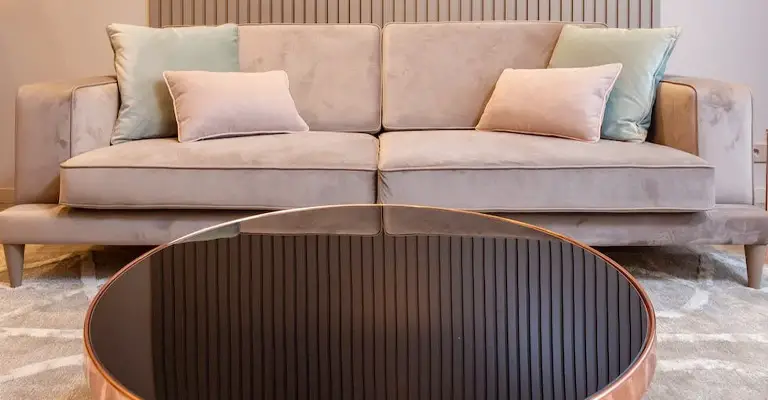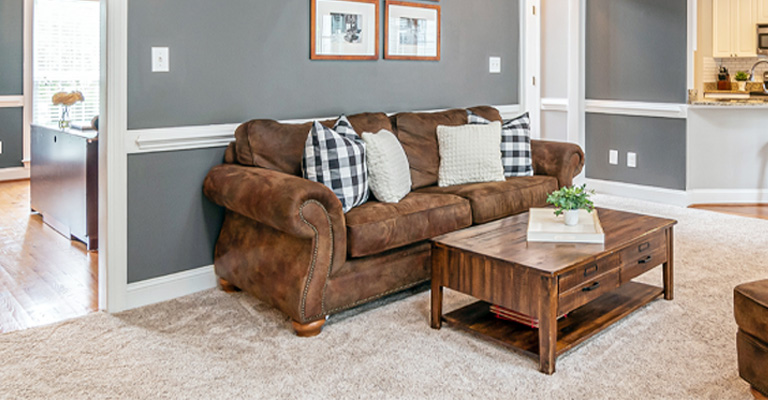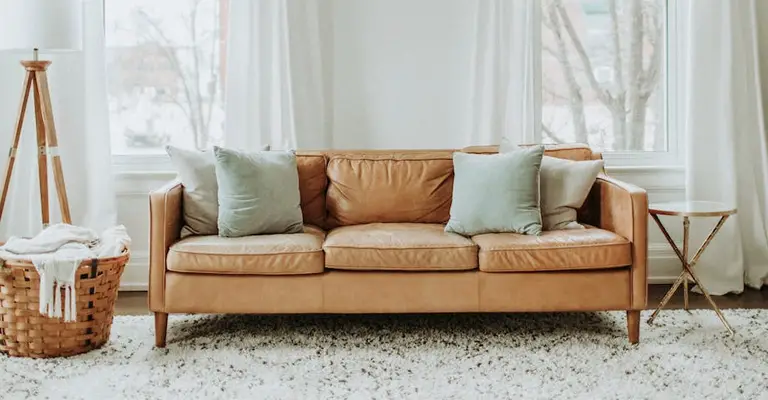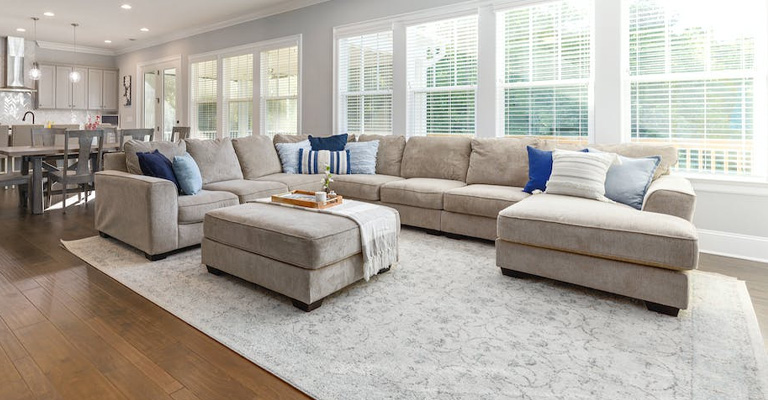You know that feeling when you’ve got this gorgeous, but slightly overwhelming, big couch? Well, fret not, because we’ve got the ultimate solution for you.
We’re diving into some seriously savvy interior design tips that’ll have your space looking like a total masterpiece.
From color wizardry to strategic placement spells, we’re about to reveal the secrets that’ll have your friends wondering how you pulled it off.

Here Is How To Make A Big Couch Look Smaller
A large sofa could be a great addition to your home for a number of reasons. There are many other aspects linked to this idea besides having a good reason for doing so.
For this reason, you need to carefully consider all the details before purchasing a huge sofa. Comfort is one of the reasons to buy an oversized sofa.
For example, a large sofa would definitely make your living room more welcoming and comfortable. As a result of the increased comfort, you will be able to create the ambiance you envisioned.
Now, if you have already purchased one, you might be looking for a way to make that big couch look smaller.
There are several design tricks you can use to make a big couch look smaller and more proportional within your living space. Here are some suggestions:
1. Scale and Proportion
Balance the size of the couch with the other furniture and elements in the room. If the rest of the furniture is small or medium-sized, the couch will appear larger.
Consider adding larger decorative pieces or furniture to help create a sense of balance.
2. Color and Pattern
Opt for lighter colors or neutral tones for the couch. Lighter colors tend to make furniture visually recede, creating a sense of airiness and space.
Avoid bold patterns or busy textures that can make the couch appear more overwhelming.
3. Legs

Choose a couch with exposed legs. Furniture with legs creates an open and airy feeling underneath, which can help the space feel less crowded. This breaks up the visual mass of the couch and makes it seem less bulky.
4. Low Profile
Look for couches with a lower back and arms. A lower profile couch can give the illusion of taking up less vertical space, making it seem smaller. This can work especially well in rooms with lower ceilings.
5. Placement
Position the couch against a larger wall or in a corner. This helps anchor the couch and prevents it from dominating the center of the room. Additionally, angling the couch slightly can visually reduce its size.
6. Scale of Accessories
Choose accessories and decor that are in proportion to the couch. Oversized pillows or artwork can actually emphasize the size of the couch. Opt for appropriately sized decor that complements the couch’s scale.
7. Minimalist Approach
Keep the area around the couch clutter-free. A clean and organized space can help minimize the visual impact of a large couch. Avoid placing too many side tables, lamps, or other items around the couch.
8. Multi-Piece Arrangement
Instead of a single large couch, consider using modular or sectional pieces. These can be rearranged to fit the available space and create a more visually manageable seating arrangement.
9. Visual Dividers
Incorporate furniture pieces or decorative screens to break up the visual flow around the couch. These dividers can help reduce the impression of a single massive unit.
10. Mirrors and Wall Decor
Strategically place mirrors or wall decor opposite the couch. Mirrors can create an illusion of depth and make the room feel larger, while artwork can draw attention away from the couch.
Reasons For Buying A Big Couch

Some people place a high value on entertaining guests. Another reason to buy an oversized sofa is because of this. Larger sofas can accommodate more guests.
To make your space feel casual, avoid super long sofas that force everyone to sit in a row if you’re trying to create an atmosphere where everyone feels comfortable.
Maybe a modular or curved sofa would be a better choice for your guests since they need to interact easily.
As we mentioned previously, modularity is another important factor that might influence someone’s decision to buy an oversized, large sofa.
One of the benefits of modular designs is that the various units can be reconfigured in various ways. This allows one to have a flexible design.
Oversized sofas are also great focal points for a room. It might be the answer to your living room’s lack of character, for example. The sofa will not only stand out but will also make the room more comfortable.
Make sure the sofa will look good in your room before you get a big one. The importance of proportion cannot be overstated.
It’s usually not a good idea to put bulky furniture in small rooms. In order for the sofa to fit well, it should be placed in a large room.
Moreover, try to visualize where you want to place the sofa before buying it. It is often difficult to accomplish this.
You have limited options because the sofa is so big. Place it in a way that makes getting in and out easy. It is usually a good idea to place the sofa against the wall.
What Is The Best Way To Know If My Couch Is Too Big?

Determining if your couch is too big for your space involves a mix of measurements and visual assessments. Here’s a step-by-step approach to help you determine if your couch is too big for your room:
1. Measure Your Room
Start by measuring the dimensions of your room, including the length, width, and height. This will give you a clear idea of the available space.
2. Measure the Couch
Measure your couch’s length, width, and depth. Compare these measurements to the dimensions of your room.
3. Allow for Clearance
Consider the necessary clearance space around the couch. This includes pathways for walking, space for opening doors, and enough room for other furniture.
A general guideline is to leave at least 18-24 inches (45-61 cm) of clearance around the couch.
4. Visualize
Use painter’s tape or masking tape to mark the outline of where the couch would go on the floor. This gives you a visual representation of the couch’s footprint in the room. Step back and assess how it fits within the space.
5. Consider Scale
Think about the overall scale of the room and the other furniture you have. If the couch overwhelms the other pieces and makes the room feel cramped, it might be too big.
6. Check Traffic Flow
Ensure that the placement of the couch doesn’t impede the natural traffic flow in the room. People should be able to move around comfortably without having to squeeze past the couch.
7. Evaluate Visual Balance
Stand at the entrance of the room and assess the visual balance. If the couch dominates the space and draws all the attention, it might be too large.
8. Functionality
Consider the functionality of the room. If the couch leaves little space for other activities or if it’s difficult to access other furniture or features, it might not be a suitable fit.
9. Personal Preference
Trust your own sense of comfort and aesthetics. If the couch feels too imposing or overwhelming to you, it’s worth considering downsizing.
10. Get a Second Opinion
Invite a friend or family member to give their opinion on the couch size in the room. Fresh eyes can offer valuable insights.
Remember that the perception of size is also influenced by the overall design and arrangement of the room. Even if a couch is on the larger side, thoughtful design choices can mitigate its impact and make it feel more proportionate.
What Is A Normal Couch Size?
A normal couch size can vary depending on the style, design, and manufacturer, but generally, a standard three-seat sofa has dimensions around:
Length: Approximately 78 to 84 inches (198 to 213 cm)
Depth: Around 32 to 38 inches (81 to 97 cm)
Height: Typically 30 to 36 inches (76 to 91 cm)
Keep in mind that these dimensions can vary based on the specific design of the couch, so it’s always a good idea to measure the exact dimensions of any couch you’re considering before making a purchase.
Additionally, variations like loveseats (smaller sofas designed for two people) or sectional sofas can have different sizes.
Final Words
The sofa’s size will make it stand out no matter what. In order to avoid adding other eye-catching or dramatic elements, reduce the number of eye-catching features in the design. Keep the decor simple.
The décor should be completed with a few throw pillows that won’t overpower the design.







